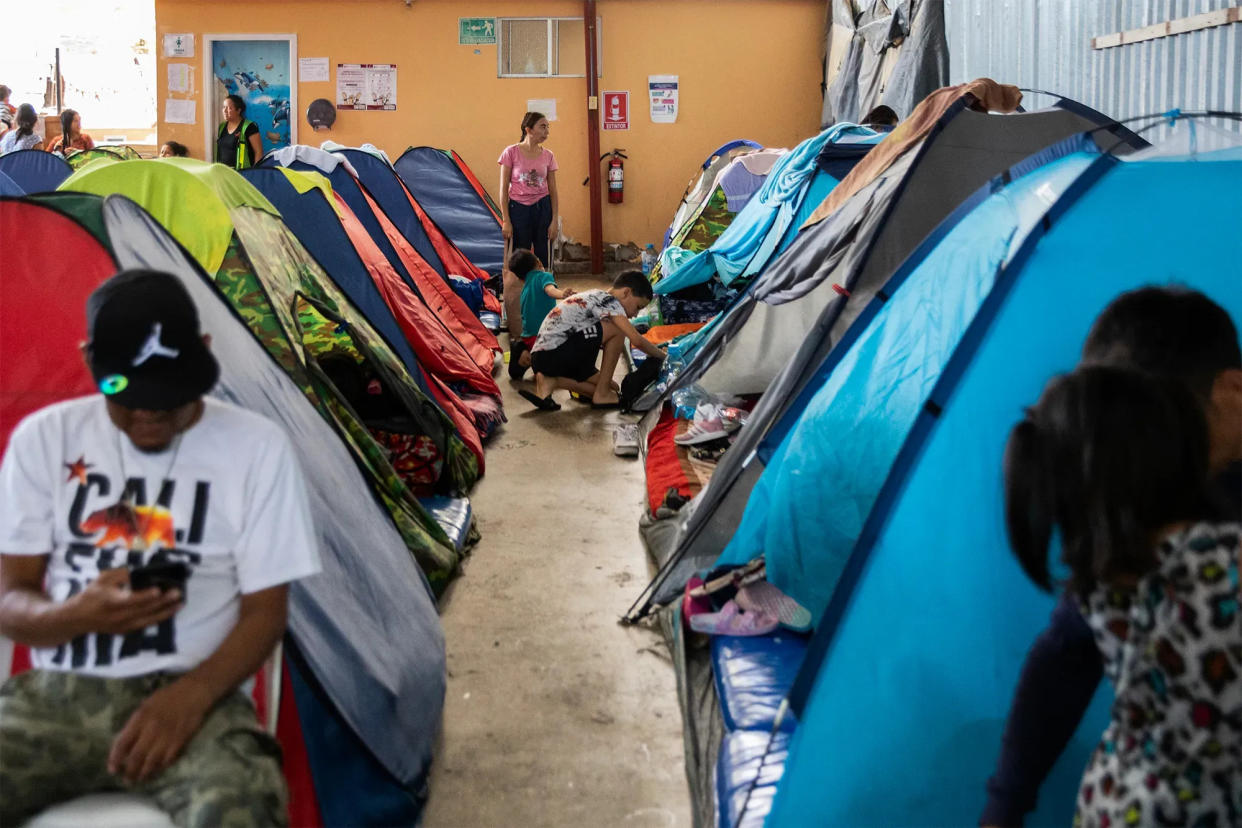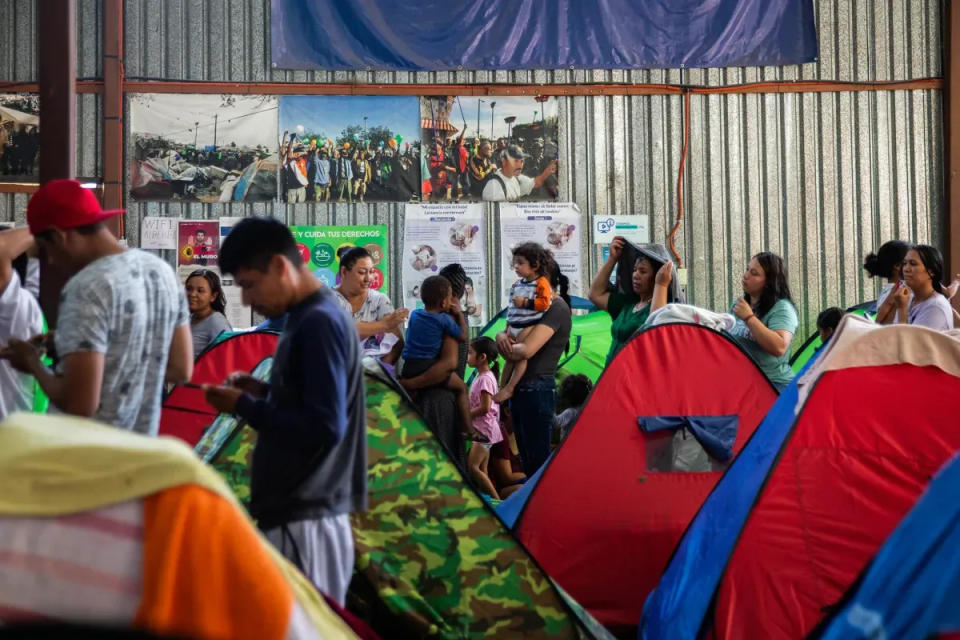Waiting game: Asylum seekers at California border at more risk during court fight

TIJUANA – María Guadalupe Cruz has been trying every day since January to get on the Biden administration’s electronic waitlist, so she could seek asylum in the United States for her and her family.
The 32-year-old mother left Honduras in 2021 with her husband and two children after local gangs tried charging a “war tax” on her home that she couldn’t pay, she said.
Organized criminal gangs fighting for territory near San Pedro Sula, the northern city where Cruz’s family lived, have progressed from extorting protection money from businesses to collecting it from households, she said.
“I told them I couldn’t pay, so they gave me 24 hours to abandon the country,” she recently told CalMatters, at the Tijuana shelter where her family lives in a tent. “And they said if we ever came back, they’d kill us all.”
The family had traveled along the northern border of Mexico, trying to find an access point where they could legally approach the United States to seek asylum.
Now it’s up to technology. The Biden Administration requires asylum seekers to seek asylum appointments through its CBP One smartphone app.
But so far Cruz, like thousands of others, has been unable to get an appointment through the Customs and Border Protection’s app using her cell phone. Mexican and U.S. authorities are blocking people without appointments from even approaching land ports of entry, contributing to increased risks at the Mexico-California border.
“I don’t want to try to throw ourselves across the (border) because I know it’s a crime,” she said. “Even though migration isn’t a crime, I just want to do everything legally. We just want to follow the rules — whatever they are — because if we don’t, and they send us back to Honduras, we’ll be killed.”
Legal challenges to asylum rules
What exactly those rules are seems to become less clear every day, she said.
A federal judge in San Francisco ruled in July that the Biden administration cannot restrict how individuals apply for asylum, even by requiring them to use an app.
The Biden Administration has appealed to the 9th Circuit Court of Appeals, asking it to block U.S. District Judge Jon S. Tigar’s decision. The administration indicated it plans to fight the issue all the way to the Supreme Court, if necessary.
The legal challenge could disrupt what had been a downward trend in the number of unauthorized border crossings at U.S. border cities, Biden administration officials warn. That outcome could substantially impact California, where many migrants arrive hoping to find more humane treatment than at other places along the 2,000-mile stretch of border.
In Texas last week, two migrants drowned near Eagle Pass, where the state has installed razor wire and floating buoy barriers in the Rio Grande to deter migrants. Although the Texas Department of Public Safety denies either migrant died from getting entangled in the barriers, Mexico President Andrés Manuel López Obrador blasted the Texas governor, calling the buoy system a ‘death trap.’
“No good person would do this,” said López Obrador at a recent news briefing in Mexico City.
California seen as safer
By contrast, California officials tout the state’s more welcoming and humane border. Gov. Gavin Newsom’s office has declined to comment on the federal asylum ruling or on California’s specific plans should the court’s stay be lifted, allowing more asylum seekers entry.
The officials have said California has helped 423,000 people since April 2021, with “temporary services and travel coordination,” and spent $1.3 billion since 2019, helping the federal government provide humanitarian services to new arrivals at the border.
“While the federal government is responsible for immigration policy and processing, California has served as a model of partnership for a safe and welcoming border, undertaking humanitarian efforts in border communities,” wrote Scott Murray, deputy director for public affairs and outreach programs for the California Department of Social Services, in a statement.
California has long been home to the largest number of immigrants in the United States. According to the American Immigration Council, they make up more than a quarter of the state’s population and a third of its labor force, and they contribute $124.3 billion a year in taxes.

The Golden State has worked around limits in federal law that bar many immigrants — those with and without legal status — from social programs. That has meant building its own, state-funded programs. But California still struggles to protect its most vulnerable citizens from such issues as wage theft and substandard housing.
The judge’s order lifting Biden’s asylum rule requiring migrants to use the app was set to take effect this week, though the federal government received a stay while it argues its case to a higher court.
A right to request asylum
In addition to requiring migrants to use the app, the Biden rule, known as the “Circumvention of Lawful Pathways,” blocks those who attempt to enter the country between designated ports of entry.
Federal law says anyone fleeing persecution may request asylum once they get a foot on U.S. soil, no matter how they got there — whether they used an app first or not, the judge said. The Immigration and Naturalization Act passed by Congress in 1965 spells that out further, saying any immigrant who has arrived in the U.S. may apply for asylum “whether or not at a designated port of arrival.”
The Biden administration argues its rule — put in place when COVID restrictions known as Title 42 ended — encourages legal pathways for immigration. The administration notes there has since been a dramatic drop in unauthorized border crossings.
Advocates say the policy amounts to an asylum ban that is harmful and not working.
They say the drop in numbers is artificial, because Title 42 led to a significant increase in “repeat” crossings by migrants who were sent back across the border only to attempt crossings multiple times a day.
Besides, advocates say, regardless of whether the app policy is working or not, it’s illegal.
“The bottom line … is that no policy that endangers lives, tramples on due process and unlawfully denies some people the right to seek asylum can be considered a success,” said Eleanor Acer, director of refugee protection at Human Rights First, a New-York based international human rights organization.
Desperate and in danger
Christina Asencio, also a director at Human Rights First, said increasingly unsafe and inhumane conditions in Mexico are making people desperate while waiting for an app appointment. Many are attempting irregular crossings.
Asencio said in the two months since Biden’s rule took effect, her team of researchers has spoken to a Venezuelan family who was kidnaped and tortured in Reynosa by members of an organized criminal group, a Honduran woman who was raped while sleeping in her tent in the encampment in Matamoros and a Central American man who was kidnapped and tortured.
She said she also met asylum seekers who “would tie cable wires around themselves and their children for fear that while they were sleeping, their children would be abducted from them.”
The federal judge agreed that families may not be safe waiting in Mexico. “The record suggests that migrants waiting in Mexico are at serious risk of violence,” wrote Tigar.
David Pérez Tejada Padilla, regional Baja California delegate for Mexico’s National Institute of Migration, issued a warning in July to migrants in Baja California to not to be fooled by smugglers who may later abandon them in extreme heat, pointing to several recent life-threatening incidents.
“The best, fastest and safest thing to do is to process your asylum application to the United States through the CBP One application, through which they authorize 12,000 entries per month from Baja California,” said Pérez Tejada.
Risks of crossing
Pérez Tejeda said approximately 10,000 migrants arrive each month in Baja California, south of San Diego and Imperial counties. They come from 46 different countries, although the majority come from Mexico and Latin America.
He said U.S. border authorities process through the app about 370 asylum seekers a day in Tijuana and 70 in Mexicali, totaling approximately 3,080 people processed weekly, he said.
“We want more people to get across safely and orderly, instead of doing it by irregular ways through the desert, rivers and mountains, risking their lives with high temperatures,” he said.
The delegate highlighted a few incidents in Julywhen migrants’ lives were endangered by smugglers encouraging people to cross into the United States without CBP One appointments.
In one incident a 9-year-old girl got separated from her family in the Tijuana river canal at night. Her family was trying to cross illegally with about 60 people. Border Patrol agents found her unharmed the next day in Imperial Beach. Authorities said she was being reunited with her family.
Choosing to stay or go
Pérez Tejeda said authorities on both sides of the border are concerned about migrants getting stuck in car trunks in higher than normal temperatures, as they attempt to cross the border undetected.
The choice to wait or to try to cross isn’t always so easy, said José María García Lara, director of the Movimiento Juventud 2000 shelter in Tijuana.
“The coordination is good between the United States and Mexico on these agreements to bring order,” he said, “but unfortunately, they forgot the human side, and the humanitarian side of the people who come here to the border with problems of insecurity. And they should be a little more sensitive and understand that these communities need help.”
The family that got separated from the 9-year-old girl had waited at the shelter for more than a month before deciding they could no longer stay put in Tijuana, he said.
The Cruz family at the Tijuana shelter, and dozens of other families from Honduras, El Salvador, Guatemala, Venezuela and Haiti are still waiting in tents at the border. García Lara said with legal rulings constantly changing the rules, families have a hard time understanding what they’re supposed to do.
Chelsea Sachau, managing attorney at Florence Immigrant & Refugee Rights Project, agrees.
“If you think that it is hard and you struggle to understand asylum laws … imagine how overwhelmed and heartbroken you would feel if your life depended on understanding it, if your child’s life depended on you understanding a system that’s been designed for you to fail at every step along the way.” she said.
Cruz says she and her family plan to continue waiting, hoping to cross legally.
“If we have to keep waiting, well, we’ll just have to keep waiting,” she said.
This article originally appeared on Palm Springs Desert Sun: Waiting game: Asylum seekers at California border at more risk during court fight

